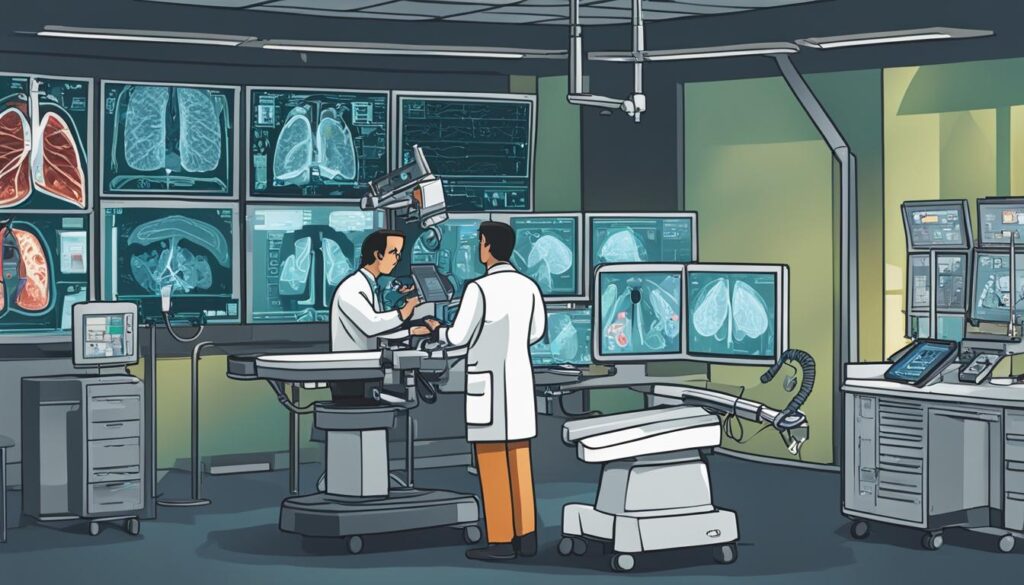If you or a loved one has been diagnosed with lung cancer, it can be overwhelming and scary. One type of lung cancer is adenocarcinoma, which is the most common type of lung cancer, making up about 40% of cases. Adenocarcinoma of the lung is a malignant tumor that develops in the cells that line the lungs. The tumor grows slowly and may not cause any symptoms in the early stages, which is why regular lung cancer screenings are crucial for early detection.
Adenocarcinoma of the lung is a serious disease, but with the right diagnosis and treatment, it can be managed effectively. In this article, we’ll provide an overview of the symptoms, diagnosis methods, and treatment options for adenocarcinoma of the lung to help you understand the disease and make informed decisions about your care.
Key Takeaways:
- Adenocarcinoma of the lung is the most common type of lung cancer, making up about 40% of cases.
- Regular lung cancer screenings are crucial for early detection.
- Adenocarcinoma of the lung grows slowly and may not cause any symptoms in the early stages.
- With the right diagnosis and treatment, adenocarcinoma of the lung can be managed effectively.
- It’s important to make informed decisions about your care and stay up to date on the latest research and advancements in the field.
Understanding Adenocarcinoma Lung
Adenocarcinoma of the lung is the most common form of lung cancer, accounting for approximately 40% of all lung cancer cases. It is a type of non-small cell lung cancer and primarily affects current or former smokers, although it can also occur in non-smokers.
Lung adenocarcinoma develops in the cells of the lung’s lining and is characterized by the formation of tumors that can spread to other parts of the body. Unlike other types of lung cancer, adenocarcinoma tends to grow slower and is more likely to occur in younger people.
While the exact cause of adenocarcinoma of the lung is unknown, certain risk factors have been identified. As mentioned earlier, smoking is a significant risk factor, as is exposure to asbestos, radon, and other carcinogens. Genetic factors may also play a role in the development of lung adenocarcinoma.
| Risk Factors: | Non-Risk Factors: |
|---|---|
| Smoking | Age |
| Exposure to asbestos and other carcinogens | Sex |
| Family history of lung cancer | Race |
It is essential to be aware of the risk factors and symptoms of adenocarcinoma of the lung to ensure early detection and timely treatment. In the next section, we will explore the common symptoms associated with this type of lung cancer.
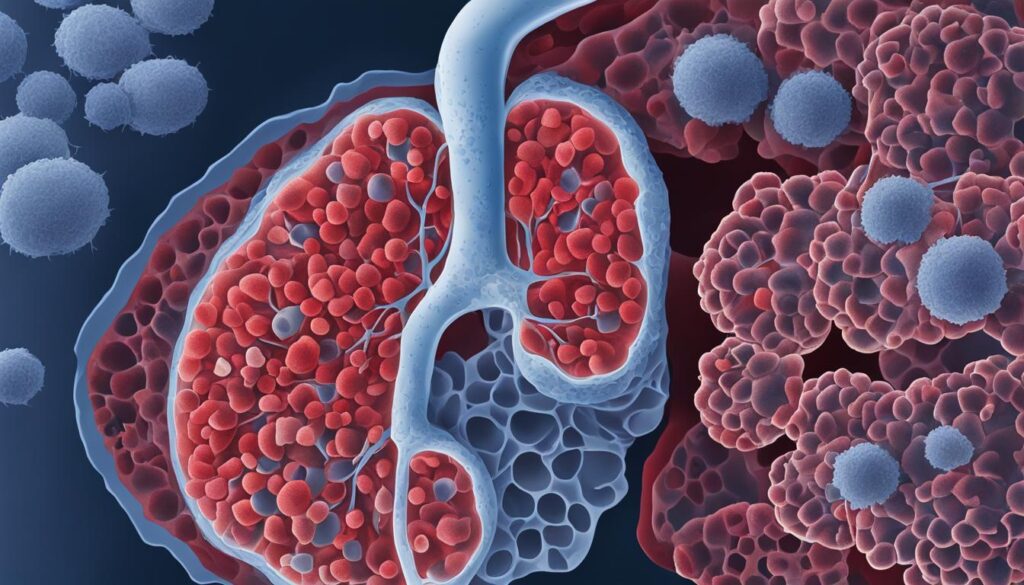
Recognizing the Symptoms
As with most cancers, early detection is key to improving the chances of recovery from adenocarcinoma of the lung. Therefore, it is essential to recognize the symptoms associated with this type of cancer.
Common lung cancer symptoms include:
- Persistent coughing that worsens over time
- Chest pain that is often felt when breathing or coughing
- Shortness of breath or wheezing
- Hoarseness or a croaky voice
- Coughing up blood or rust-colored sputum
- Fatigue and loss of appetite
- Unexplained weight loss
- Persistent infections, such as bronchitis or pneumonia
If you experience any of these symptoms, it is important to see your doctor as soon as possible. Keep in mind that these symptoms are not exclusive to lung cancer, and could also be caused by other respiratory conditions.
To help diagnose the cause of your symptoms, your doctor may recommend a series of tests, including imaging tests, biopsies, and blood tests. These tests can help confirm the presence of adenocarcinoma of the lung or rule out other conditions.
In some cases, you may not have any symptoms until the cancer has progressed to a later stage. Therefore, it is important to attend regular health check-ups, especially if you are at increased risk of developing lung cancer.
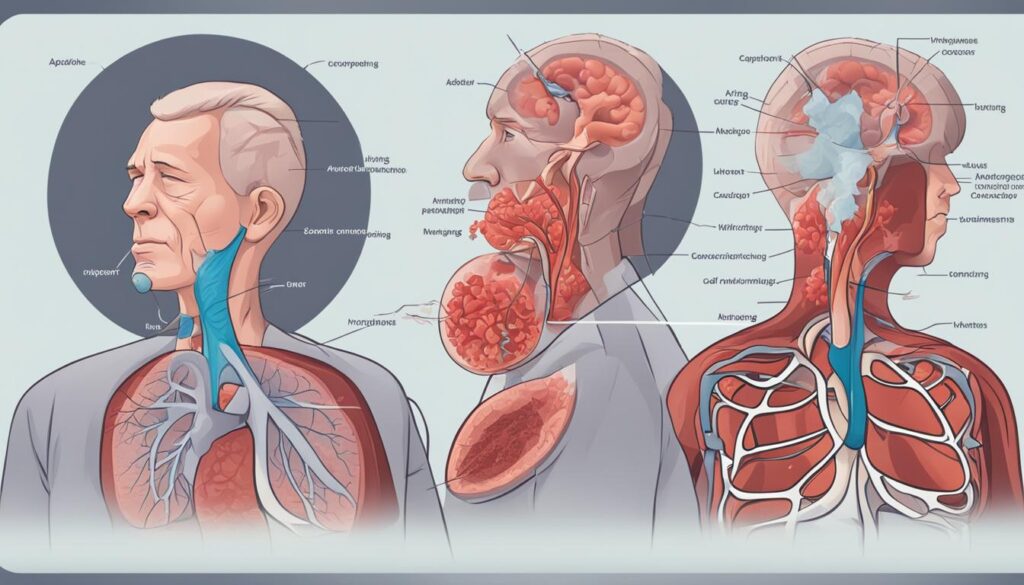
Diagnosis Methods
If you experience any of the symptoms associated with adenocarcinoma lung, seeking medical attention and receiving an accurate diagnosis is critical to determining the appropriate treatment options. The diagnostic process typically involves a combination of imaging tests and biopsies.
Imaging Tests
The first step in diagnosing adenocarcinoma of the lung is typically an imaging test, which helps to identify any abnormalities or masses in the lung. Common imaging tests include X-rays, CT scans, PET scans, and MRI scans. These tests allow doctors to determine the size, location, and spread of the cancer, which helps to guide treatment decisions.
One important imaging technique for diagnosing lung cancer is the low-dose CT scan, which is recommended for individuals at high risk of developing the disease. This type of scan uses a lower dose of radiation than a standard CT scan and has been shown to be an effective tool for early detection of lung cancer.
Biopsies
If an imaging test indicates the presence of a lung tumor or mass, a biopsy may be necessary to confirm a diagnosis. During a biopsy, a small tissue sample is removed from the lung for examination under a microscope.
There are several types of biopsies that may be used to diagnose lung cancer, including:
- Needle biopsy: A needle is inserted through the chest wall or into the lung to remove a tissue sample.
- Bronchoscopy: A thin, flexible tube with a camera is inserted into the trachea and bronchi to visualize the lung tissue and take a biopsy.
- Thoracotomy: A surgical procedure in which an incision is made in the chest and a tissue sample is removed.
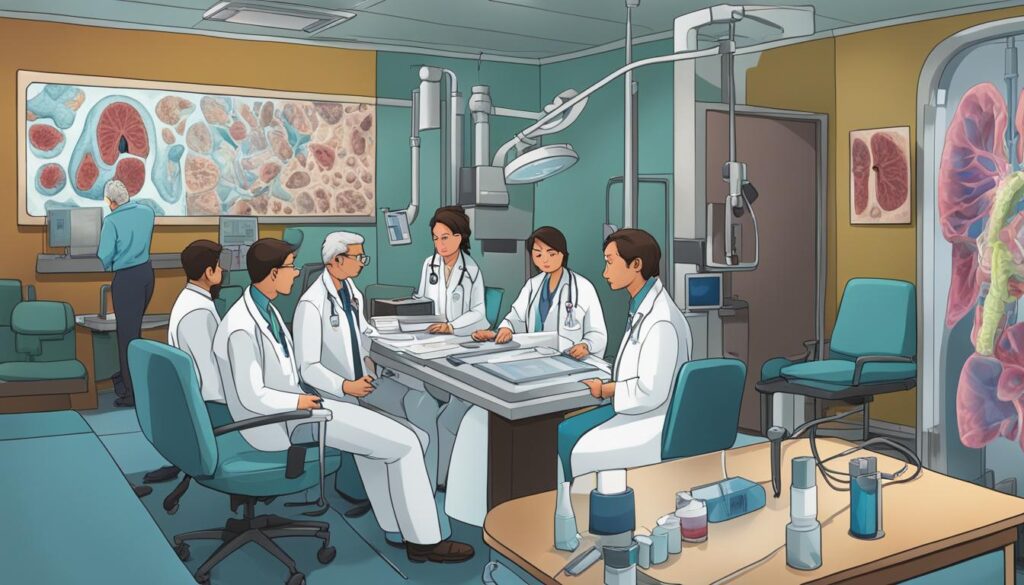
“Early detection is key to effective treatment and improved outcomes for individuals with adenocarcinoma lung.”
Once a diagnosis has been confirmed through imaging tests and biopsies, doctors will determine the stage and extent of the cancer to develop an appropriate treatment plan. Stay informed about diagnostic methods and ask your healthcare provider about the options available to you.
Treatment Approaches
If you have been diagnosed with adenocarcinoma of the lung, there are several treatment options available. The type of treatment you receive will depend on the stage of cancer, overall health, and personal preferences. Here’s an overview of the various treatment approaches:
Surgery
If the cancer is localized and hasn’t spread to other areas of the body, surgery may be an option. During the procedure, the surgeon will remove the tumor and a portion of healthy tissue surrounding it. In some cases, a lobectomy (removal of a lobe of the lung) or pneumonectomy (removal of the entire lung) may be necessary. Surgery is generally more effective for early-stage lung cancer.
Chemotherapy
Chemotherapy involves the use of drugs to kill cancer cells. It can be given before or after surgery to help shrink the tumor or prevent the cancer from returning. Chemotherapy may also be used to alleviate symptoms and prolong life in cases where the cancer has spread beyond the lungs.
Radiation Therapy
Radiation therapy uses high-energy radiation to destroy cancer cells. It may be used before surgery to shrink the tumor and make it easier to remove, or after surgery to kill any remaining cancer cells. Radiation therapy may also be used to alleviate symptoms, such as pain or difficulty breathing, in cases where surgery is not an option.
Targeted Therapies
Targeted therapies are medications that target specific genes or proteins that contribute to the growth and spread of cancer. They are typically used for advanced-stage lung cancer and may be given in combination with chemotherapy or radiation therapy.
Immunotherapy
Immunotherapy involves using drugs to boost the body’s immune system to fight cancer. It may be used alone or in combination with other treatments. Immunotherapy is a relatively new treatment approach and is generally reserved for cases where other treatments have not been effective.
It’s important to discuss the available treatment options with your doctor and work together to determine the most appropriate course of action based on your individual circumstances.
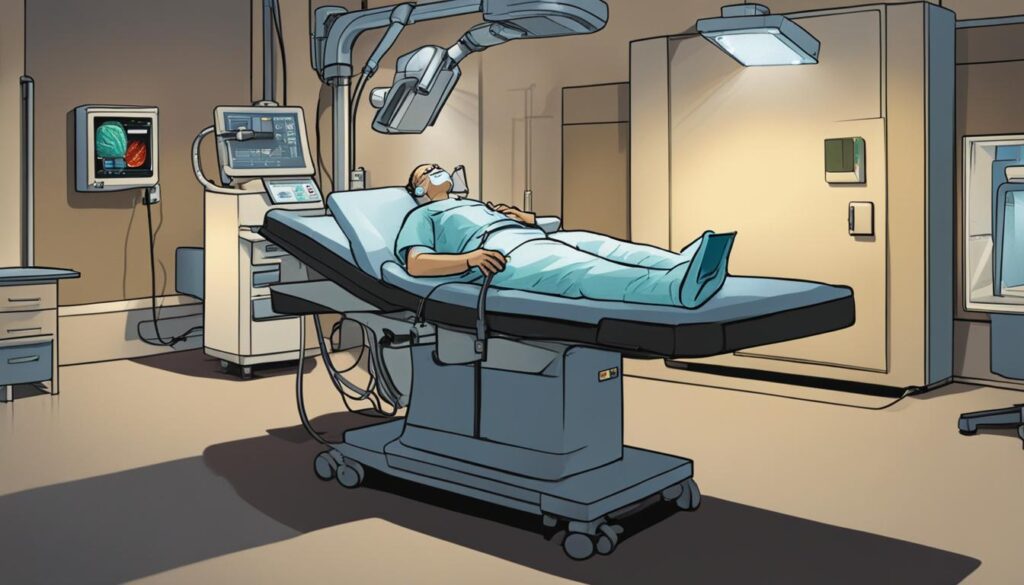
Prognosis and Survival Rates
Prognosis for adenocarcinoma of the lung depends on several factors. These include the stage and extent of the cancer, age and overall health of the patient, and the effectiveness of the selected treatment approach.
It is important to note that survival rates for patients with adenocarcinoma of the lung have improved in recent years, thanks to advances in treatment and early detection measures. The overall 5-year survival rate for lung cancer is approximately 20%. However, survival rates vary depending on the stage of the cancer at the time of diagnosis.
For patients with early-stage adenocarcinoma of the lung, the 5-year survival rate is around 60%. This drops to around 30% for patients with advanced-stage disease. It is important to note that these are general statistics, and individual prognosis may vary based on each patient’s unique circumstances.
Factors that Influence Prognosis
Several factors may influence the prognosis for adenocarcinoma of the lung. These include:
- The size and location of the tumor
- The stage and grade of the cancer
- The presence of any mutations or genetic alterations in the cancer cells
- Age and overall health of the patient
- Response to treatment
Patients with adenocarcinoma of the lung who have mutations in the EGFR gene or ALK gene may have a better prognosis and respond well to targeted therapies. Patients with KRAS mutations, on the other hand, may have a poorer prognosis and be less responsive to treatment.
Long-Term Survival
Long-term survival for patients with adenocarcinoma of the lung is rare, but it is possible. According to recent studies, between 3-7% of patients with stage IV adenocarcinoma of the lung survive for 5 years or longer.
Research is ongoing to identify new and more effective treatments for adenocarcinoma of the lung. Clinical trials are currently exploring the use of immunotherapies, targeted therapies, and other innovative approaches. These advances offer hope for improving the prognosis and long-term survival rates for patients with this type of lung cancer.

Risk Factors and Causes
Adenocarcinoma of the lung is caused by a combination of genetic and environmental factors. The primary cause of this type of lung cancer is exposure to carcinogens, particularly cigarette smoke. Smoking is the leading cause of lung cancer and accounts for nearly 85% of all cases. Secondhand smoke and exposure to air pollution, radon, asbestos, and other toxic substances also increase the risk of developing lung cancer.
Individuals who have a family history of lung cancer or who have previously received radiation therapy to the chest area are also at a higher risk of developing adenocarcinoma of the lung. Furthermore, genetic mutations such as epidermal growth factor receptor (EGFR) and anaplastic lymphoma kinase (ALK) can increase the likelihood of developing lung cancer.

Research has shown that certain lifestyle factors can also contribute to the development of lung cancer. A diet low in fruits and vegetables, physical inactivity, and obesity are known risk factors for various types of cancer, including lung cancer. Exposure to stress and a lack of social support may also increase the risk of developing lung cancer.
Summary of Risk Factors and Causes
| Risk Factors | Causes |
|---|---|
| Smoking | Exposure to carcinogens, particularly cigarette smoke |
| Secondhand smoke and air pollution | Exposure to toxic substances |
| Family history of lung cancer and previous radiation therapy to the chest area | Genetic mutations, such as EGFR and ALK |
| Lifestyle factors, such as a low fruit and vegetable diet, physical inactivity, and obesity | Exposure to stress and a lack of social support |
It is important to understand the risk factors and causes associated with adenocarcinoma of the lung to reduce the risk of developing this type of lung cancer. Quitting smoking, avoiding exposure to toxic substances, and adopting healthy lifestyle habits can help reduce the risk of developing lung cancer.
Emerging Research and Advances
As research continues into adenocarcinoma lung, advances are being made in the field of lung cancer treatment. Trials are underway that explore new medications, immunotherapies, and targeted therapies that may offer more effective treatment options.
One such approach is immunotherapy, which works by using the body’s own immune system to attack cancer cells. This treatment can be effective in treating advanced lung cancer and is being explored as a first-line treatment option for some patients.
In addition to new treatment approaches, advancements are also being made in the area of early detection. Scientists are developing new screening methods that may identify the disease in its earliest stages, allowing for earlier interventions and improved outcomes.
Role of Genetic Testing
One area of research that shows particular promise is the use of genetic testing to identify specific mutations that may be driving the growth of the cancer. This allows doctors to tailor treatment plans to the individual needs of each patient.
Targeted therapies, which are medications that are designed to specifically target cancer cells with certain mutations, are becoming an increasingly important part of treatment for adenocarcinoma lung.
Researchers are also exploring new combinations of existing treatments, such as combining immunotherapy with chemotherapy or radiation therapy. These approaches may offer improved outcomes for patients with advanced lung cancer.
Progress in Clinical Trials
Clinical trials are a critical part of advancing treatment options for adenocarcinoma lung. These trials involve testing new medications and treatments in human subjects to evaluate their effectiveness and determine any potential side effects.
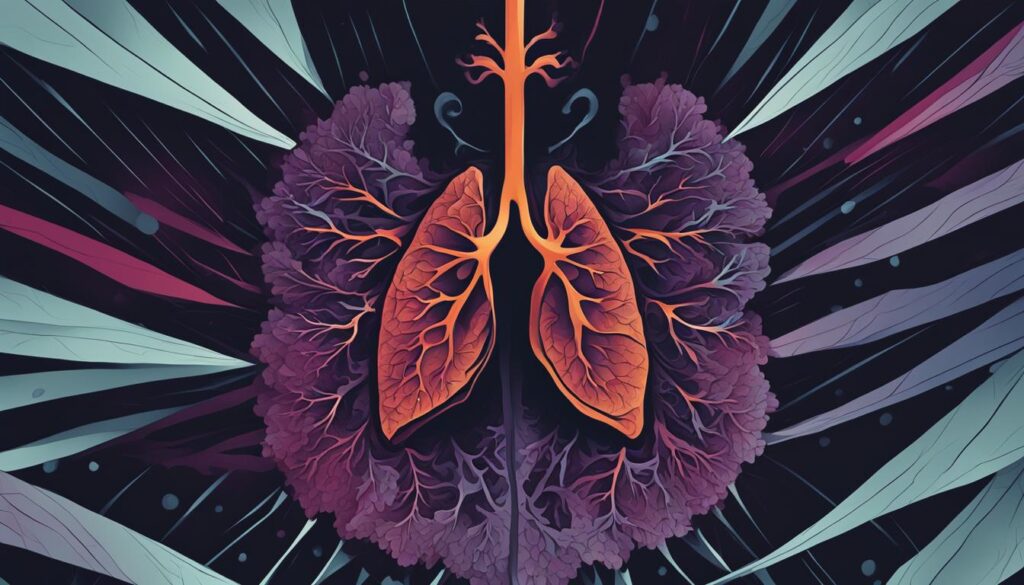
Clinical trials are ongoing and offer hope for new, more effective treatments in the future. If you are interested in participating in a clinical trial, speak with your doctor to learn more about available options.
Lifestyle Changes and Supportive Care
If you have been diagnosed with lung cancer, making lifestyle changes and seeking supportive care can be beneficial for your overall well-being.
First, consider making dietary changes. A diet rich in fruits, vegetables, whole grains, and lean proteins can boost your immune system and promote healing.
Regular exercise can also help manage symptoms and improve your quality of life. Aim to incorporate at least 30 minutes of moderate physical activity into your daily routine.
Coping with a diagnosis of lung cancer can be challenging, and seeking psychological support is essential. Consider joining a support group or speaking with a counselor to help manage stress and anxiety.
Supportive care can also include symptom management, such as pain relief and medication for nausea and vomiting. These interventions can help alleviate discomfort and improve your overall quality of life.
Finally, it’s important to have open and honest communication with your healthcare team. This can help ensure that you receive the best possible care and support throughout your treatment journey.
By making lifestyle changes and seeking supportive care, you can improve your physical and emotional well-being while managing your lung tumor or lung cancer.
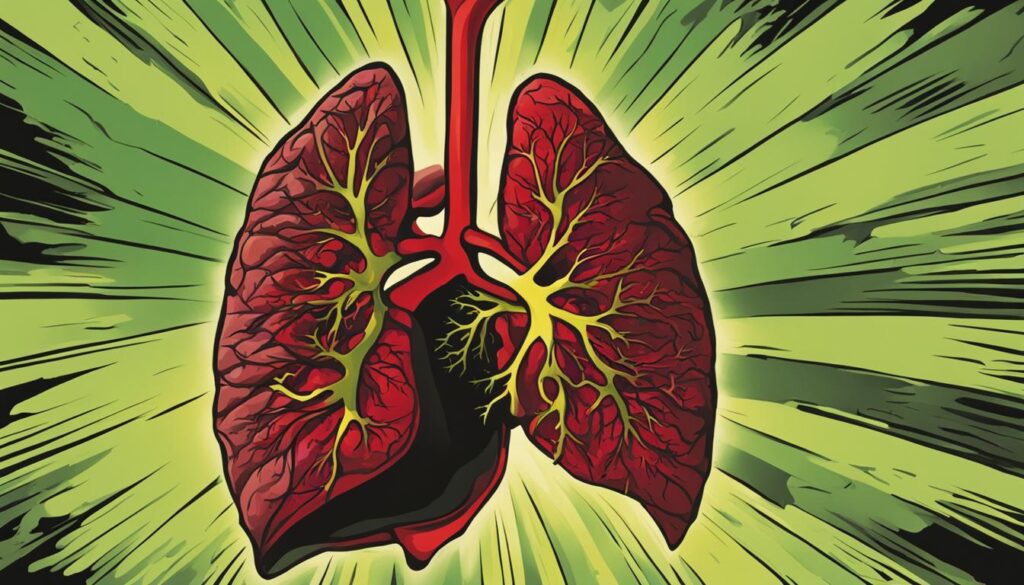
Conclusion
Now that you have a better understanding of adenocarcinoma of the lung, you can take an informed approach to managing this condition. By recognizing the symptoms, seeking early diagnosis, and exploring the available treatment options, you can work with your healthcare team to make the best decisions for your health.
Stay up-to-date with the latest research and advancements in the field to ensure you have access to the most effective treatments. Remember that lifestyle changes and supportive care can also play an important role in managing this disease and improving your overall well-being.
We hope this article has provided valuable insights into adenocarcinoma lung, lung cancer, lung tumor, lung cancer diagnosis, lung cancer treatment, lung cancer prognosis, lung cancer causes, lung cancer symptoms, and lung malignancy. Stay informed and stay healthy!
FAQ
What are the common symptoms of adenocarcinoma of the lung?
Common symptoms of adenocarcinoma of the lung include persistent cough, shortness of breath, chest pain, coughing up blood or mucus, fatigue, and unexplained weight loss.
How is adenocarcinoma of the lung diagnosed?
Adenocarcinoma of the lung is typically diagnosed through a combination of imaging tests, such as chest X-rays and CT scans, and a biopsy, where a small sample of lung tissue is examined for cancer cells.
What are the treatment options for adenocarcinoma of the lung?
Treatment options for adenocarcinoma of the lung may include surgery to remove the tumor, chemotherapy to kill cancer cells, radiation therapy to target the tumor with high-energy radiation, targeted therapies that attack specific cancer cells, and immunotherapy that boosts the body’s immune system to fight cancer.
What is the prognosis for adenocarcinoma of the lung?
The prognosis for adenocarcinoma of the lung varies depending on factors such as the stage of the cancer, the overall health of the individual, and their response to treatment. It is important to consult with a healthcare professional for an accurate prognosis.
What are the risk factors and causes of adenocarcinoma of the lung?
Smoking tobacco is the leading cause of adenocarcinoma of the lung. Other risk factors include exposure to secondhand smoke, exposure to carcinogens such as asbestos and radon, a family history of lung cancer, and certain genetic mutations.
Are there any emerging research and advancements in the treatment of adenocarcinoma of the lung?
Yes, there is ongoing research and clinical trials exploring new treatment approaches for adenocarcinoma of the lung. These advancements include targeted therapies, immunotherapies, and personalized medicine approaches that aim to improve outcomes and survival rates.
What lifestyle changes and supportive care can help manage adenocarcinoma of the lung?
Making healthy lifestyle choices, such as quitting smoking, exercising regularly, and eating a balanced diet, can help manage adenocarcinoma of the lung. Additionally, seeking psychological support and participating in support groups can provide emotional support during the treatment journey.
